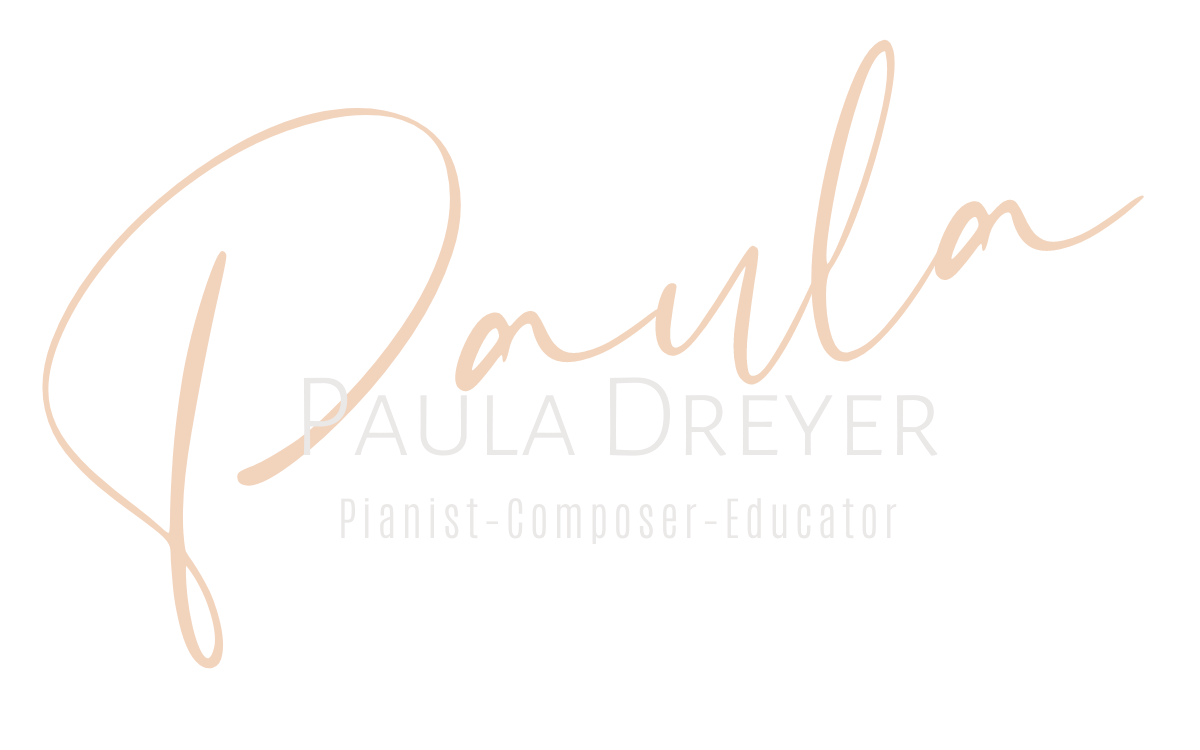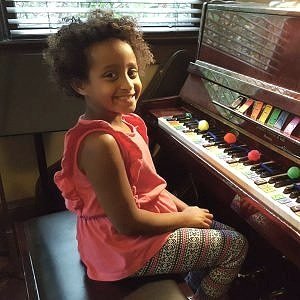About Rote Pieces
What are rote pieces?
They are easier to learn by listening and watching than by reading.
They can be taught by demonstration and they often sound appealing, expansive, and most likely have some repeated patterns.
Students consult the score to see how the sounds are represented in the music and are taught how to read music, as well as how to use their ear.
The eyes, ears and kinesthetic senses are all working together.
The Little Gems Primer and Beginner Levels work well by rote, and by Volume 2, students are able to read the notation.
Students can easily learn the Little Gems pieces through:
Teacher demonstration
Traditional reading skills
Listening to the audio files and strengthening their ear
Studying them through online video tutorials.
-
Ignite the Creative Spark through Rote Pieces
Little-Gems.png
Is teaching a rote piece cheating? I asked that question in a past post and it caught the attention of Paula Dreyer who has written books full of rote pieces. After chatting, it turns out we have extremely similar views on teaching by rote and she was kind enough to share her perspective on the benefits of it in her guest post.I particularly appreciate how Paula connects rote pieces to teaching creativity. Brilliant!
-Leila
Do you ever feel like you want to see that spark reappear that inspired a student to take piano lessons in the first place? It's no secret that many people are drawn to the magical sounds of the piano. They love the way it sings and echoes and vibrates and they can't wait to begin to learn how to play. And then lessons begin.
Volume-2-cover-Amazon-232x300.jpg
With some traditional method books, students are taught a small number of notes and a small number of rhythms and then they learn to read pieces that use these small sets of notes and rhythms. And then, we wonder what happened to that spark...
Reading music is a highly complex skill that requires time, patience and practice. Reading is an extremely important skill that can be balanced with learning by rote. When one learns by rote (listening and mirroring a teacher's demonstration), that small set of notes and rhythms can be put aside and digested until the next time you work on reading skills. The whole piano range is up for grabs, countless rhythms can be used, and the combinations of scales, modes and harmonies are endless.
How lucky are we as piano teachers, to teach a field that inherently has potential to capture curiosity and motivation!? We are not teaching a dry, lifeless subject. We are teaching music. Humans (usually) love music. We don't need to convince students to feel connected to music. The difficulty lies in trying to keep the spark alive throughout the challenges, trials and errors of learning an instrument.
Connection and Exploration
I have a series of three books full of patterned rote pieces called Little Gems for Piano. Each piece in the Primer Little Gems book offers creative suggestions such as simple transpositions, improvisational ideas and meter changes. My favorite benefit of rote pieces is their ability to connect the student to the music. My students' first recital is full of rote pieces. "Thunder Showers" is a big it in my studio and I am grateful to Tim Topham for including it in his No Book Beginners. Here is a video of my student playing it beautifully during his third piano lesson. He is very quiet in lessons and he could not help smiling while playing this imaginative piece!
To explore meter changes, we learn about how "Thunder Showers" would sound if it only had three beats in every measure. We chant and move to rhythmic patterns using three beats per measure, and then the student takes the same bass line and RH black key clusters and experiments with the sounds of 3/4. If you are interested in a free download of this piece, be sure to subscribe on www.littlegemsforpiano.com.
Improvisation
Improvisation can be a useful way to get the student connected to the piano. Rote Pieces lend themselves well to improvisation. They often are pattern-based and these patterns can easily be transposed, leading the piece in a new direction. The patterns often use an interesting yet small set of melodies and harmonies.
Once the student is taught how to resolve the piece at the end, they can go very far with pattern transpositions. The possibilities are endless. They can explore different tonalities, experiment with new rhythms such as swinging the 8th notes, or expand the pattern and incorporate the entire scale. When the piece uses a small set of notes over a repeated bass line, question and answer techniques are very effective because almost everything will sound good!
FullSizeRender-15-2.jpg
Here is an example of "Dream Waves" from Little Gems Volume 1.
With this piece, the student could
swing the 8th notes
alternate swung and straight 8ths
take the motive even higher on the keyboard
expand or contract the motive
transpose to new key areas
play question and answer with the teacher.
I am working on a set of duets for Volume 1 where the student and teacher play the piece as written (including a teacher duet), and then they play the piece again with the student improvising on top of the teacher duet part. I am excited about the creative possibilities this new book will have.
Just yesterday, a teacher sent me a video of her student playing "Blinking Stars" from the Primer Level. The student accidentally learned the piece centered around the two black keys instead of the three black keys. The new position gave the piece a much more haunting sound and they have decided to play the new version in the upcoming spooky-themed recital. Because of their expansive nature, rote pieces naturally lend themselves to exploration and transformation.
Composition
Composition can also be explored through rote pieces. Usually, the pieces are not harmonically complex, so you can work within small parameters and easily experiment.
I tell my students that when I compose, I'm really just improvising until I find something I like and then I write it down.
There are many directions I could take my pieces, but I finally decide on a way I like and write it down. Of course, from there, the real compositional work begins, but improvisation is a great starting point for composition.
I am finding my students naturally gravitate towards composing. Here is an example of a piece my student composed with no help from me. In fact, I did not even assign a composition assignment. She simply created it on her own and it sounds like something that might come from my Little Gems for Piano book that she is working out of.
I decided to leave this piece as is, as I was excited that she came up with the entire concept from start to finish on her own.
If I had wanted to "workshop" the piece, we could have experimented with
Writing a contrasting section
Adding an intro or ending section
Sequencing the main motive higher or lower
Reversing the direction of the motive.
We are currently working on these concepts with a new composition.
I encourage my students to explore the compositional concept of a rote piece and create their own piece. For example, if a piece has a repeated bassline and a small set of notes in the RH, we come up with a new bassline and a new set of notes in the RH and see where it takes us. Then, we might change it to minor, or swing the rhythm, etc.
If a piece is pattern-based and has both hands playing the same rhythm, we might come up with a new pattern and take it to different areas, shorten the pattern, lengthen it, etc. If the piece is in 5/4, they come up with their own motive that has 5 beats per measure.
Because rote pieces are often very clear and simple, (compositionally, not in sound--they actually sound complex) concepts can be taught easily and then expanded creatively.
I think we can all agree that our final goal as teachers is to develop an independent, confident pianist who is a competent sight-reader with a solid technique who plays with musicality and expression.
Maybe you also have the goal of creating improvisers and composers. Rote pieces can help facilitate each of these characteristics. Their appealing and impressive sounds give motivational, inspirational boosts that balance all of the hard work and dedication it takes to become a complete musician.
What tools do you use to keep your beginners engaged and enthusiastic during those crucial first couple of years of studies?
-Paula Dreyer
Paula-headshot.jpg
Paula Dreyer is an active teacher, performer and educational composer in the San Francisco Bay Area. She has composed piano pieces for “Basic Alignment and Rotation”- an overview of the Taubman approach, and the class piano book “PianoLab”. She has performed at world-class venues such as Carnegie Hall and Green Music Center, has a Master of Music from SF State University, Bachelor of Music from McGill University and graduated from Interlochen Arts Academy.
Her students have won local and state awards. She is a long time faculty member at the Community Music Center of San Francisco and is the author of the instructional piano books "Little Gems for Piano." She has a real passion for composing unique, accessible and enjoyable music for beginners and loves sharing her compositions with students around the globe. www.littlegemsforpiano.com and www.pauladreyer.com
PS: These pieces could be perfect for your spring recital.



